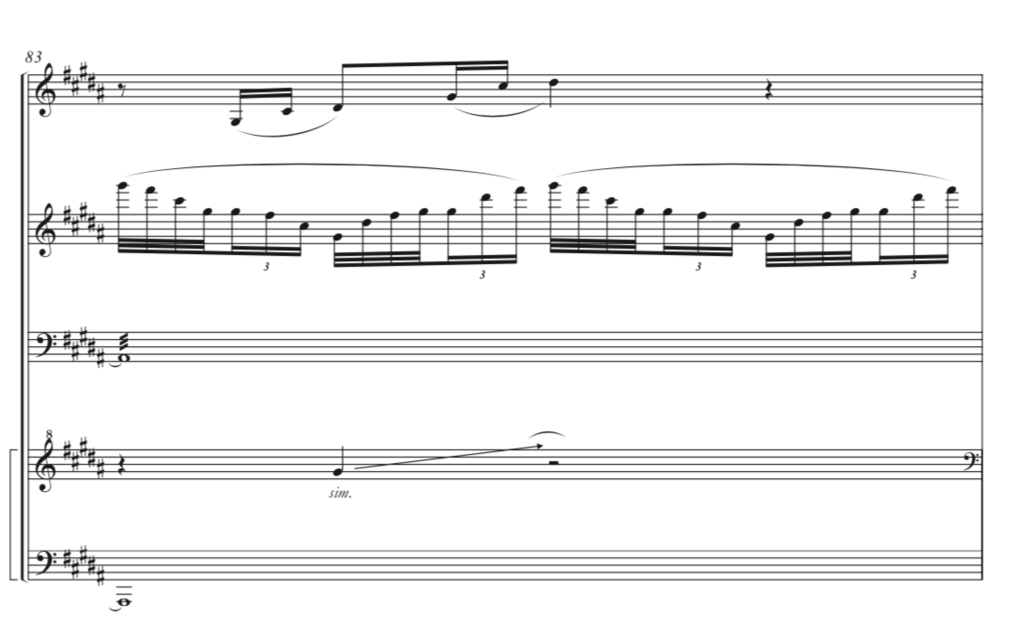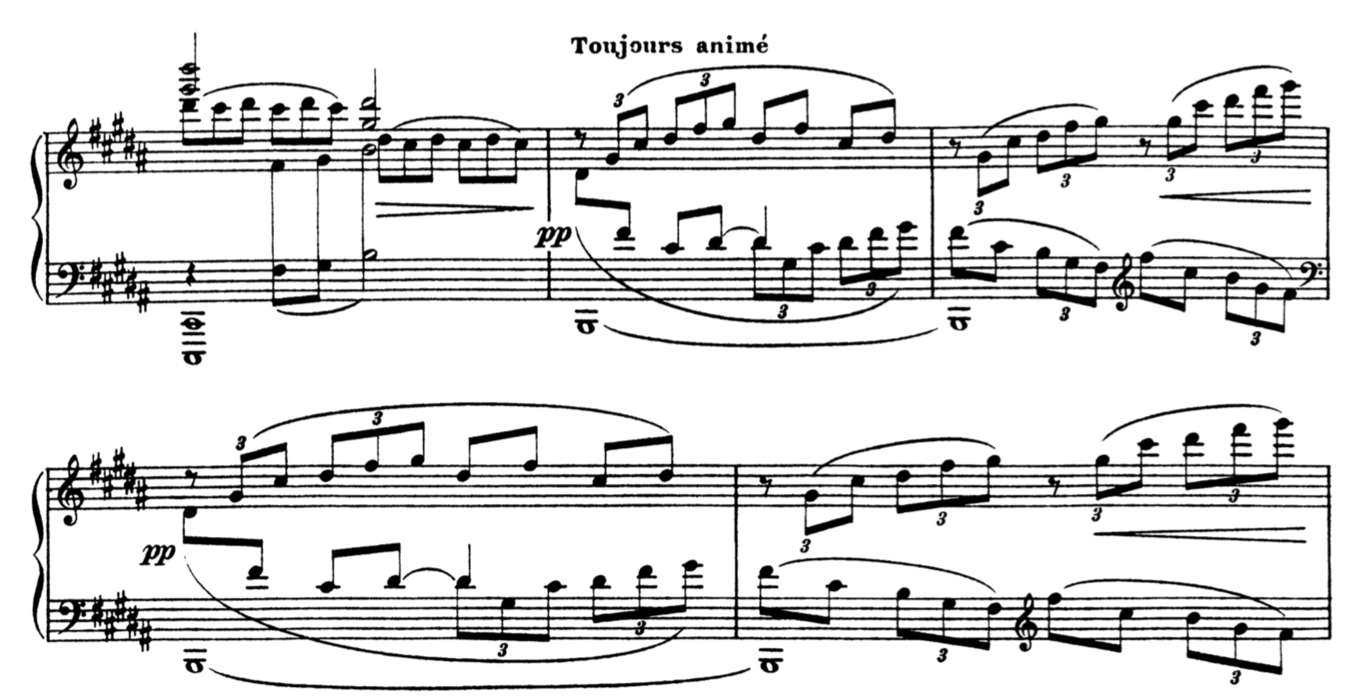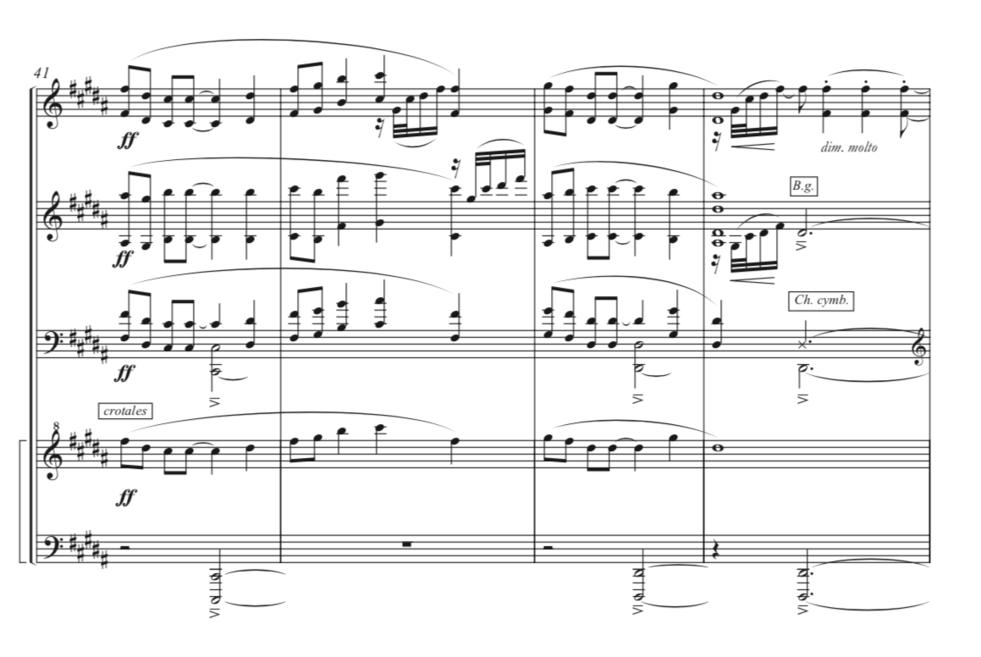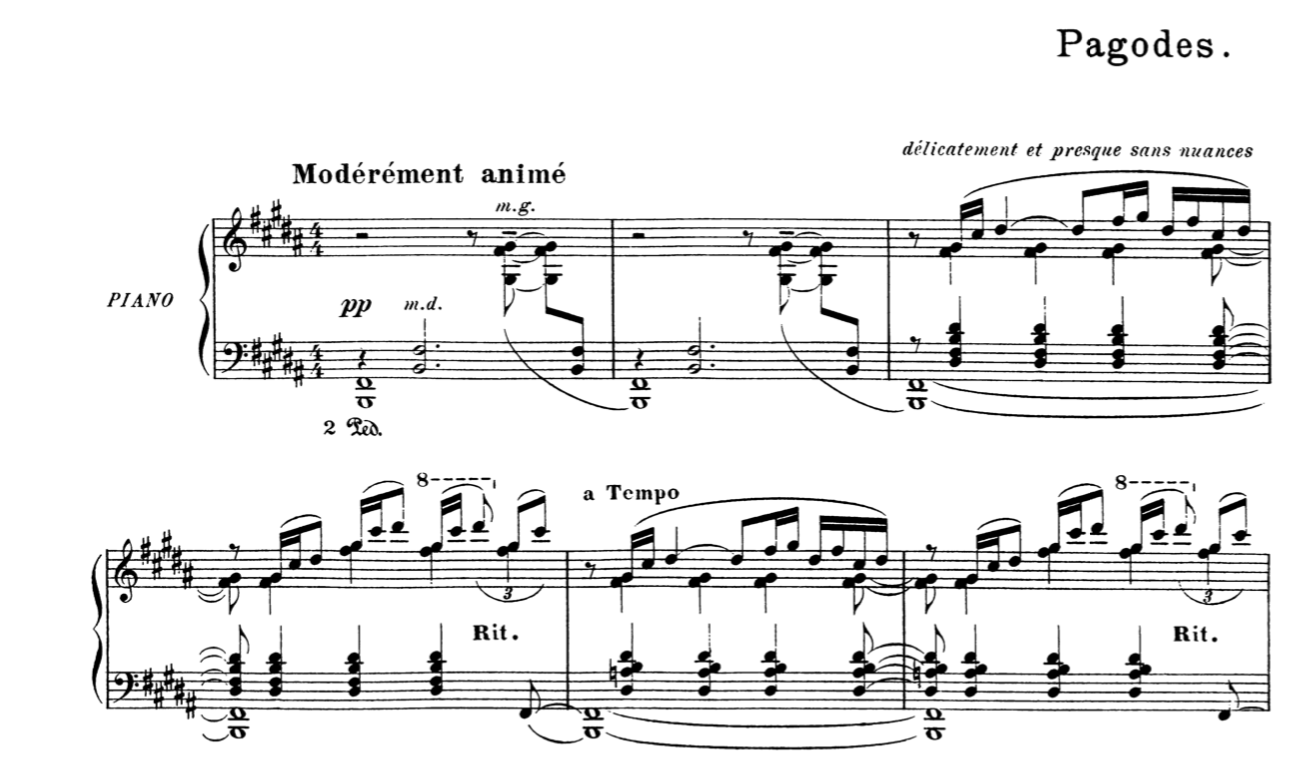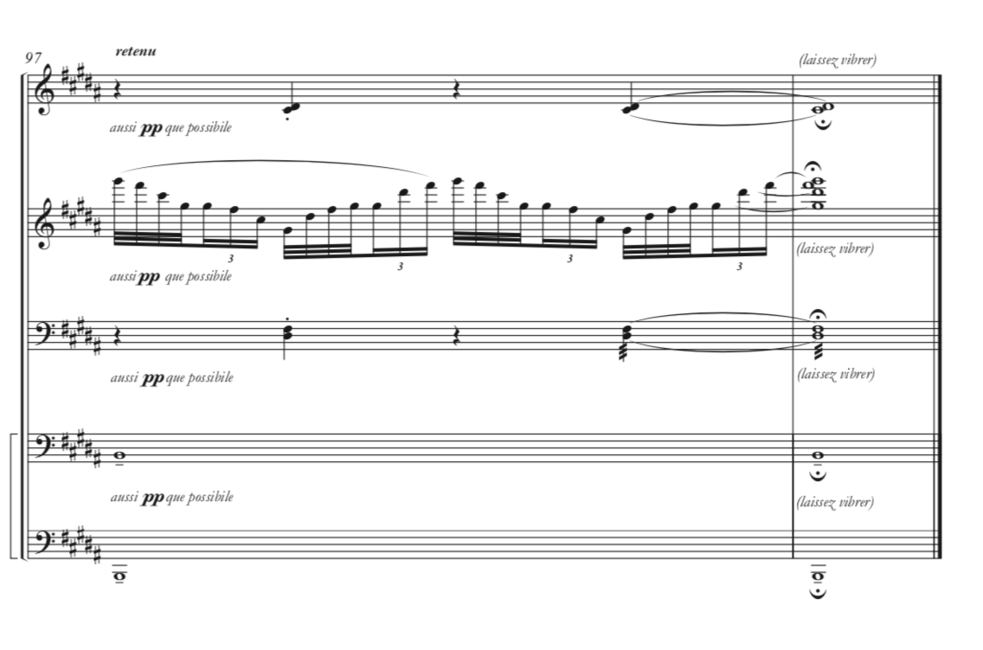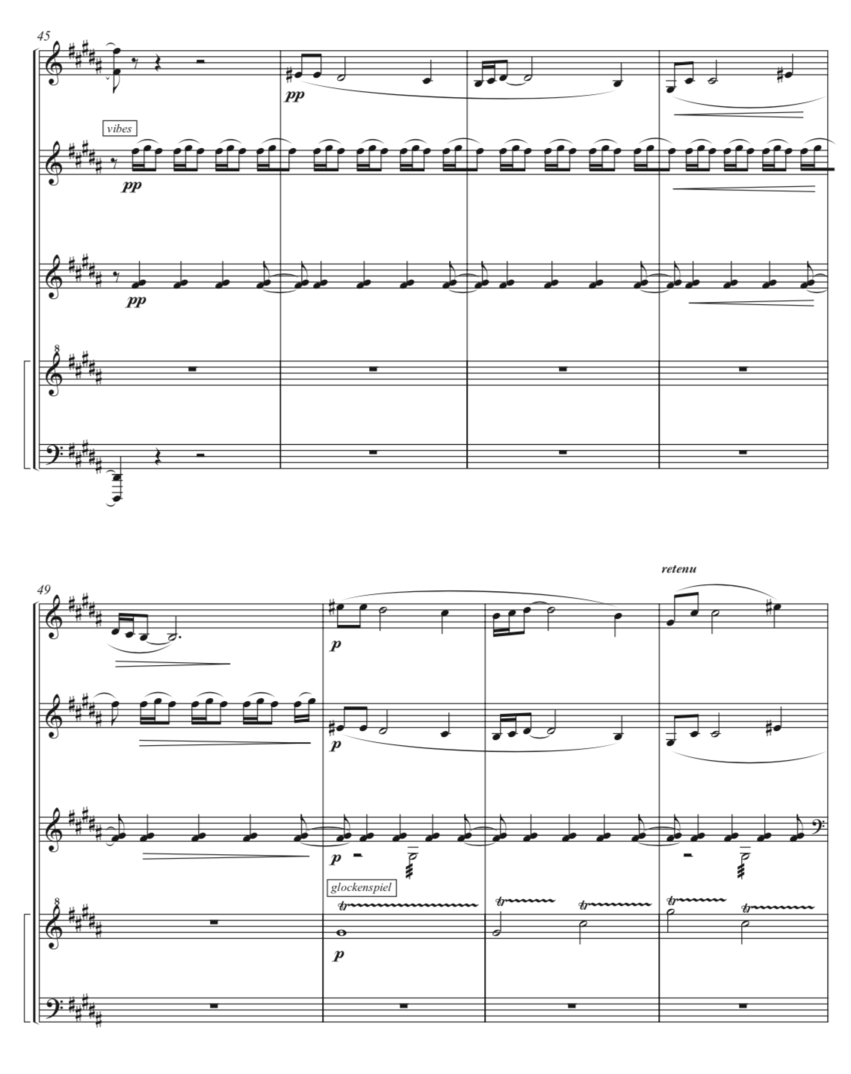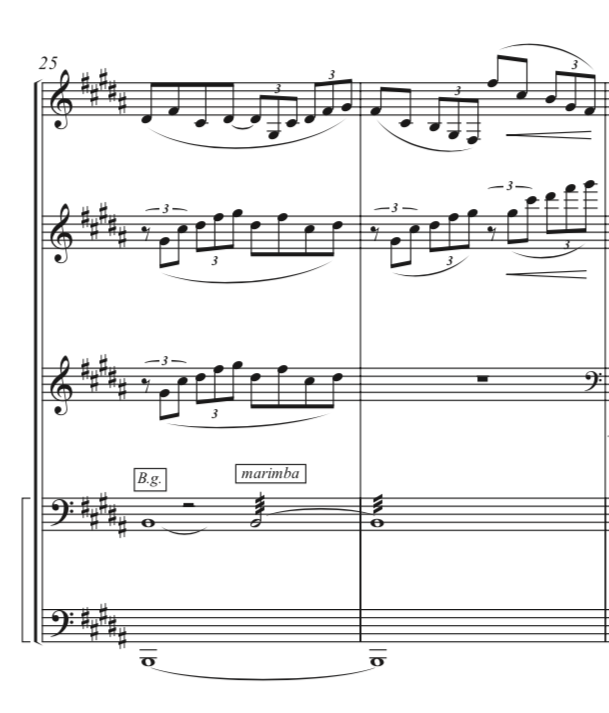Pagodes from Claude Debussy's Estampes, performed by Amadinda Percussion Group (transcription: Aurél Holló on the 36th Festival Internacional de Música de Espinho, Portugal 2010 July.
There is a melody in the middle surrounded by a lot of lines written in a canonic way. As usual in this transcription, Holló gives the melody to vibraphone 1 and spreads the moving lines between both the two vibraphones and the marimba. It is interesting to notice that, in the recording, the marimba player picks a pair of harder mallets to fuse better with the colour and timbre of the vibraphones. Important also is the hit on the Burma gong in B (and the continuation with the same note in tremolo on the low register of the marimba) at the beginning of each two bars, giving impulse and energy to the other voices.
Moving forward, I wanted to highlight the crescendo from bar 37 to a climax in bar 41, where we see a fortissimo for the first time in the piece. After a build-up of four bars with an ascending melody and a fast and anxious motive that moves up and down repetitively, we reach a fortissimo where Holló writes the melody in unison in all parts and in various instruments and registers (vibraphone, marimba and crotales). This melody is accompanied by eruptions of the fast motive (shared by the two vibraphones), finishing this section with a hit on the cymbal and the Burma gong (supported by the bass line in the marimba and the sampler) that creates the resonance from which the next section is born. This section marks the return of a melody played by the first vibraphone in piano which has already been heard before but with the addition of an accompanying motive in the second vibraphone. The melody is later doubled in a different octave by the other vibraphone, with the glockenspiel playing trills with soft mallets (to match the sound of the vibraphones) in a beautiful texture that makes a bridge to the re-exposition of the first theme of the piece.
After presenting the same themes and material, and after reaching the same climax that happens in bar 41, Debussy makes a bridge of four bars before he begins a coda. In this bridge we see the transformation of the tripletmotif into a fast motif that moves up and down in register and gradually changes in meter, but always while keeping the flow of movement, as if it was a water cascade moving uninterruptedly. This bridge, in Holló’s transcription is marked by the use of higher pitched Burma gongs, returning to an ‘oriental’ feeling.
Aurél Holló, in his arrangement, is extremely successful both in the translation of Debussy’s ideas to another family of instruments, and in taking advantage of the marvellous possibilities of the percussion world. The transcription is written to be played by four percussionists, with each one being responsible for specific colours, and specific layers during the piece.
CHAPTER II:
Analysis of works related to the research
In this second chapter I will analyse two works that are relevant for my research in different ways, but both with the goal of gaining technical, orchestration and creative skills that have helped me in the creation of the arrangement I made. I will focus on technical and timbrical features of percussion instruments, in the way in which the composers and arrangers deal with colour and textures with those same instruments, and how to truly translate very good piano writing to that family of instruments.
Aurél Holló’s transcription of Debussy’s Pagodes (from Estampes) for percussion quartet
Like Et la lune Descend sur le temple qui fut, in Pagodes, Debussy explores the use of musical idioms from Oriental music, with particular highlight to the Javanese gamelan. The piece is filled with space and resonance and constantly uses several pentatonic melodic lines to make the connection to oriental music clear. But in spite of the clear gamelan music influences the piece is, both structurally and harmonically in western form.
Both of the mentioned pieces require a more percussive approach, in terms of touch and movement. Although they are both pianistically organic, one should not approach this work as a pianist, in a merely physical sense, that is why I find the choice of interments for this arrangement so interesting.
Aurél Holló, in his arrangement, is extremely successful both in the translation of Debussy’s ideas to another family of instruments, as well as he is at taking advantage of the marvellous possibilities of the percussion world. The transcription is written to be played by four percussionists, each one responsible for specific colours, and specific layers during the piece.
This syncopated feeling stops in the 11th bar, where for the first time (since the beginning of the melody) we feel the downbeat, marked by the entrance of the cymbal on the first beat of the bar. From here and in the next four bars we are presented with two melodies: one of them is more strict grounded and played on the beat, giving us a feeling of balance, and the other keeps the same unstable feeling of the beginning, with triplets in the first bar and quarter notes played in the upbeats on the second. For these reasons Hollo writes the first melody in octaves on the first vibraphone and reinforces it on the marimba one octave down, and the second melody is played in the second vibraphone, also written in octaves, in slurs of two bars.
This section is followed by a more minimal four bar phrase, written just for the two vibraphones, where a simple melody is accompanied by an uneasy repetitive motive of triplets in two notes. This motive continues and is expanded when we get to Animez un peu in bar 19, whose entrance is marked by a crescendo from a piano to a piano: i.e., a crescendo until bar 19 and a subito piano at the beginning of the bar. This transition is beautifully translated in Aurel Holló’s arrangement, and impeccably interpreted by Amanda Percussion Group. The triplet motive is shared between the marimba and the first vibraphone, in different octaves, the melody and ascending chords are written for the second vibraphone, and the most important line in this four-bar phrase, the base line played by performer 4 with tremolos in the low register of the marimba, with very soft and highly resonant mallets. This bassline, in this transcription, is responsible for the change of colour at the piano subito in bar 19, and for leading the crescendo until bar 22 with the help of the tremolos, in an effect that is incredibly expressive and impossible to reproduce in the piano.
From the beginning of the piece we can already see that there are three layers of musical material happening at the same time: first we hear the base, a bourdon pedal in the left hand composed by a fifth with G and D. In the first two bars there is a small introduction to this movement in the form of a rhythmic ostinato where the fifths of the left hand lead us to an accentuated chord on the upbeat, giving us a syncopated dance feeling that will perdure until bar 11. This ostinato will, in the third bar, transform itself into an accompaniment layer in the middle register with a repetitive rhythmic pattern in the upbeats of the bar. At the same time, we get to a third layer, a pentatonic melody that always moves from the upbeats of the bar, always together with the second layer of accompaniment. Just from the first four bars we can understand the oriental influence of this music, in a still but somewhat unbalanced landscape, made possible by the ambiguity the fact that the music is moving from upbeats.
In Holló’s transcription these layers are perfectly represented, both in terms of register and colour. For the two introduction bars, Holló chose instruments with high resonance, the marimba and Burma gongs. The pedal note in the bass is played in a low Burma gong in B and a sampler to reinforce and give power to the bass, and the other two layers of this dance-like ostinato are written for marimba and another set of higher pitched Burma gongs. The arrival of a melody introduces us to a new instrument, and therefore, to a new colour: the vibraphone, with syncopated accompaniment played in the marimba and another vibraphone. As the melody goes up in pitch, Hollo makes use of the glockenspiel in a beautiful continuation of the colour of the vibraphones in another register.
Toujors animé is a good section for understanding how helpful it can be for a pianist to dissect and isolate the musical material in order to understand how to balance a highly contrapuntal passage and have a clear idea of what they want to stand out.
Aurél Holló's transcription of Claude Debussy's Pagodes from Estampes for percussion quartet: first 4 bars.
Aurél Holló's transcription of Claude Debussy's Pagodes from Estampes for percussion quartet: bars 76 to 78.
Aurél Holló's transcription of Claude Debussy's Pagodes from Estampes for percussion quartet: bars 83, 97 and 98.
Aurél Holló's transcription of Claude Debussy's Pagodes from Estampes for percussion quartet: bars 9 to 24.
Conclusions taken form Holló’s transcription:
Holló’s arrangement is a marvellous lesson in orchestration for percussion instruments. The way he not only fully understands Debussy’s work of art, but actual expands its universe in such a rich and refined way is truly remarkable. I took a lot of colours from this transcription, such as the association of the marimba to the gongs in order to get resonance. In very specific moments, Holló writes an attack in the gong that is immediately continued by a tremolo in the low register of the marimba, thereby maintaining and expanding the resonance. I use this technique in several moments of my arrangement. Like Holló, I also write most of the melodies in the vibraphone and connect its colour and timbre with the glockenspiel, which gives the possibility of expanding the register without a big change in the nature of the sound.
I want to take this opportunity to thank Aurel Holló for generously giving me access to the scores of his arrangement and for showing interest in my work.
In the Coda Debussy shows again the melodies that have already been presented before, but in a lower register and under a cloud made by the cascading motif in the right hand, until it finishes in a beautiful B major chord with a sixth and a ninth. In Holló’s transcription the cascading motif is played by the second vibraphone, while the other instruments paint the atmosphere around it, with the melody in the vibraphone 1, tremolos in the low register of the marimba supported by the sampler, and glissandi in the black keys of the glockenspiel.
In the last six bars the marimba helps the vibraphone with colouring and resolving the melody, while the Burma gongs play B every two bars, with a truly hypnotic and fluctuating feeling until reaching the final chord.
Aurél Holló's transcription of Claude Debussy's Pagodes from Estampes for percussion quartet: bars 41 to 52.
Aurél Holló's transcription of Claude Debussy's Pagodes from Estampes for percussion quartet: bars 25 and 26.

